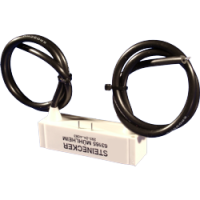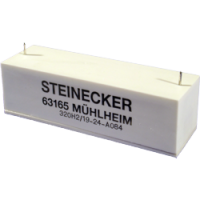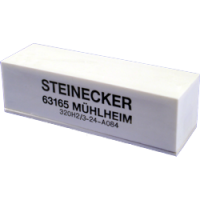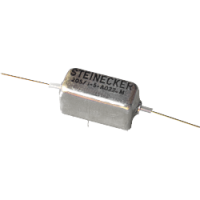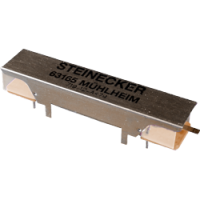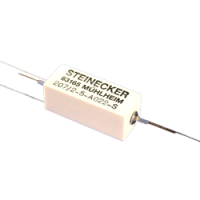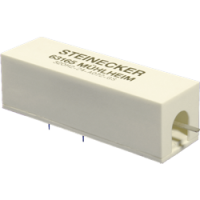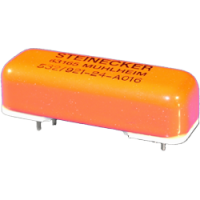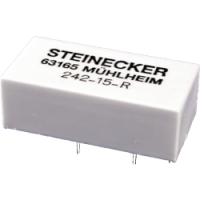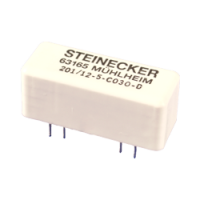Reed relay for durable and reliable switching

A reed relay switches very low voltages (nV) or high voltages (10kV/DC) reliably and with a long service life. It is characterised by a high insulation resistance (up to 10^14 Ohm) and a long service life. Furthermore, they have a low contact resistance (typ. 50 mOhm) and switch quickly (typ. 1ms), which is very crucial for some applications.
Your advantages
Product examples
Here you can see an exemplary selection of reed relays. In addition, we also offer other product variants
-
Reed relay 293
Read More- Switching voltage up to 10 kV
- Enclosed with insulating material
- Molded high voltage cables
-
Reed relay high voltage 294
Read More- Switching voltage up to 7,5 kV
- Enclosed with insulating material
- opt. with cable connection
-
Reed relay 320H2/1, 320H2/19
Read More- Switching voltage up to 10 kV
- Enclosed with insulating material
-
Reed relays 205 high insulated
Read More- high insulated resistance, up to 10 TOhm
- Axial reed contact connections
- Cast metal housing
-
Reed relay high insulated 719, 720, 729, 730
Read More- magnetic shield
- High insulation resistance 10 TOhm
- electrostatic screen
-
Reed relay Highly insulated: 238
Read More- High insulation resistance, up to 10 TOhm
- Axial reed contact connections
- Plastic housing moulded
-
Reed relay high insulated 207/2, 208/2
Read More- High insulation resistance, up to 10 TOhm
- Axial Reed Contact Connections
- Potted plastic housing
-
Reed relay high insulated 320H2
Read More- High insulation resistance 10 TOhm
- Switching current up to max. 3 A
- optional magnetic screen
-
Reed relays 531, 532, 533, 534
Read More- At vero eos et
- accusam et justo
- duo dolores et ea rebum
- Stet clita kasd gubergren
- no sea takimata sanctus est
-
Reed relays 241, 242, 243, 244
Read More- At vero eos et
- accusam et justo
- duo dolores et ea rebum
- Stet clita kasd gubergren
- no sea takimata sanctus est
-
Reed relays 201, 202, 203, 204
Read More- High pack density
- Can be available in 14-pole DIP versions
- Insulation case shed
You have questions about our products or
need a personal consultation?
need a personal consultation?
Product informations
Our reed relays operate according to the simple and long-lasting principle of reed technology. A reed switch with 2 ferromagnetic switch blades are hermetically enclosed in a glass body. They are therefore protected from pollution and other environmental influences. This ensures a constant low contact transition resistance with high reliability and long service life. If a current flows through the coil, a magnetic field is generated. This affects the 2 ferromagnetic switches so that they attract each other and thus close the contact.
The reed relay consists of the following components:

- 1 or more reed switch, inside the coil
- Coil for generating the magnetic field
- Optional diode to suppress voltage spikes of coil
- Optional Magnetic screen
- Housing
- Connection Pins
Comparison: Semiconductor Relay | Reed relay
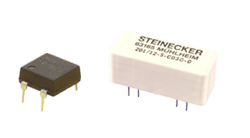
Semiconductor relays use the switching behavior of specially controlled transistors, mostly based on FET switches.
Because of the internal reed switch the insulation resistance of Reed relays is much higher than for the semiconductor types. They have a certain leak current due to the design. The capacity of a semiconductor relay is much bigger. Reed relays generally have a potential separation from the signal path, which is not the case with the semiconductor types.
Comparison: Mechanical relay | Reed-Relais
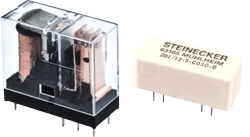
Reed relays have a mechanical life (for small loads) that is 10 to 100 times longer than mechanical relays because they have less moving
parts. They switch by a factor of 10 faster, due to the easier and easier setup of the switching points. The isolation values with open contact are significantly higher, up to 10^14 ohm. Similarly, you need less power to switch contacts than for mechanical types. In addition, reedrelais can be switched at a high switching frequency of several hundred Hertz. The average downtime rate (MTBF) is also well over 100,000 hours.
In order to respond to your specific requirements in the best possible way, the Reedrelais are available in various versions. We use different reed switches inside the relay to relize specific electrical parameters.
You get the relay with different pinnings for PCB assembly.
We also provide you with axial relay types. As an option, you can order these with diode, magnetic or electrostatic screen , or as a highly insulated version for special requirements.
Highly insulated
High-insulated reedrelais are used for applications in measurement technology with high demands for interference signal suppression. This design offers insulation resistance of up to 10 TOhm, with a low leak current, a constant transition resistance, an electrostatic and magnetic screen and all in a high-primal design.
Magnetic Shield
A shielding hood made of ferromagnetic material prevents the influence of external magnetic fields on the relay. This is also used when the relays are placed close to each other on a board. This prevents mutual influence.
Static Shield.
An optimal shielding of the contacts between each other and the coil is achieved by CU-tubes around the reed contact. They also reduce the pruning of the contacts and thus the interference voltage by magnetic resistance. This reduces the tightening and waste delay of the eddy currents caused by this construction.
Reed relays can be found in various basic variants:
- Standard
- DIL version
- Highly insulated
- High voltage.
You can choose between normally open, normally closed and change over contacts .
There are single-pole and multi-pole relays, i.e. one or more switching contacts.
You can get the relays with our standard pinning, but also define your individual connection pinning.
Optionally, a diode can be integrated into the relay to suppress voltage spikes. An optional magnetic shield allows the shielding of external magnetic fields, which can otherwise cause the relay to malfunction.
Selectable Product Parameters:
- Coil voltage DC: 5V, 6V, 9V, 12V, 18V, 24V, 36V or 48 volts
- Mounting: printed circuit board, surface mount
- Switch contact: close (form A, SPST), opener (form B, SPNO), changer (form C, SPDT)
- One or multipole (DPST)
- Electrical parameters (switch voltage, switch current, switch power)
- Diode
- Magnetic Shield

